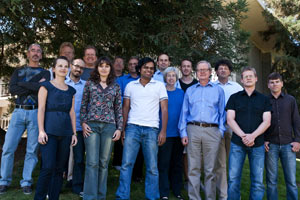
Handy Links
SLAC News Center
SLAC Today
- Subscribe
- Archives: Feb 2006-May 20, 2011
- Archives: May 23, 2011 and later
- Submit Feedback or Story Ideas
- About SLAC Today
SLAC News
Lab News
- Interactions
- Lightsources.org
- ILC NewsLine
- Int'l Science Grid This Week
- Fermilab Today
- Berkeley Lab News
- @brookhaven TODAY
- DOE Pulse
- CERN Courier
- DESY inForm
- US / LHC
SLAC Links
- Emergency
- Safety
- Policy Repository
- Site Entry Form

- Site Maps
- M & O Review
- Computing Status & Calendar
- SLAC Colloquium
- SLACspeak
- SLACspace
- SLAC Logo
- Café Menu
- Flea Market
- Web E-mail
- Marguerite Shuttle
- Discount Commuter Passes
-
Award Reporting Form
- SPIRES
- SciDoc
- Activity Groups
- Library
Stanford
Around the Bay
SUNCAT: Working to Catalyze Energy Advances
SUNCAT—the Center for Sustainable Energy through Catalysis—is a new initiative in the SLAC Photon Science Directorate that will focus on creating better catalysts for use in alternative energy industries. The center is lead by Jens Nørskov, who arrived at the beginning of June from his previous appointment as director of the Center for Atomic-scale Materials Design at the Technical University of Denmark.
Nørskov and his team want to gain such a clear and comprehensive understanding of catalytic processes that they can actually develop a theoretical basis for the design of new and better catalysts—"basically going from quantum mechanics to designing a new material," Nørskov said. Catalysts are materials that can affect chemical reactions without themselves being changed. They're already widely exploited in industrial chemistry, but most catalysts now in use are far from perfect. Some are not efficient, while others include rare elements, and are thus expensive. Some, such as platinum (used to split water into hydrogen and oxygen), are both.
One new class of materials Nørskov and his crew want to design would help capture the energy of the sun and store it in a form usable as fuel. In fact, SUNCAT is part of the Joint Center for Artificial Photosynthesis, a new Energy Innovation Hub created by the Department of Energy to do just that. The key to artificial photosynthesis is an energy-efficient way to "reduce" carbon dioxide—in other words, strip the oxygen off the molecule—in order to combine the carbon with hydrogen to make the fuels we burn.
"It hasn't yet been proven that this is possible," said SUNCAT staff scientist Frank Abild-Pedersen. "People have just discovered this field again." But if SUNCAT scientists can pull it off, that could, indeed, reduce the amount of carbon dioxide contributing to global warming.
Artificial photosynthesis is only one process that requires catalysts, though. Felix Studt, also a staff scientist at SUNCAT, discussed two other alternative energy technologies that could benefit: biofuels and batteries.
"We want to find different routes to biofuels," Studt said. So-called "first generation" biofuels are made from the same materials that can feed us, and therein lies the problem. Whom do we feed? Our machines or ourselves?
One option is to switch to "second generation" biofuels, derived from cellulose from materials such as wood chips or straw. However, this requires preprocessing to prepare the biomass for fermentation into bioethanol, itself an energy-intensive process. Another option, the option SUNCAT researchers are working on, is to convert biomass directly into a substance called "syngas."
"You can essentially gasify everything organic," Studt said, and from there, "you can convert syngas into pretty much any hydrocarbon." But efficiency is again a sticking point, as the catalyst used during the conversion process depends on the desired hydrocarbon, and using the wrong catalyst can result in unwanted byproducts. But given that SUNCAT researchers look at energy conversion processes which might someday be implemented at very large scales, "even small boosts in efficiency become very important," Studt explained.
A boost in battery efficiency would also be welcome, and to that end SUNCAT researchers are working on lithium-air batteries. Such batteries would be more energy-efficient than the current lithium ion batteries because they would pull the oxygen required for the energy-generating reactions directly from the air. Lithium-air batteries can theoretically gain energy densities (the amount of usable energy in a certain volume) close to those of current hydrocarbon fuels such as gasoline.
Currently, the majority of SUNCAT staff members at work on these projects are theorists, most of whom accompanied Nørskov from Denmark. But the design stage is only the beginning. After theory comes "characterization," or determining whether the SUNCAT-designed material actually does what the theorists think it will do.
Characterization is where Anders Nilsson comes in. "My background is to understand chemical interactions on surfaces using X-rays," Nilsson explained. He's not only the deputy director of SUNCAT, he's the experimental side of the team and has already begun to put theory to the test using soft X-rays at both the Stanford Synchrotron Radiation Lightsource and the Linac Coherent Light Source. He also already has experience with improving the efficiency of platinum as a catalyst for fuel cells.
"If we want to make sustainable energy choices, we need catalysis," Nørskov said. "I would like us to develop a good enough understanding of these phenomena to contribute a little bit. I'm not saying we'll solve it, but putting one brick in this wall would be good."
—Lori Ann White
SLAC Today, September 14, 2010
